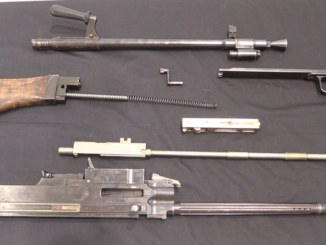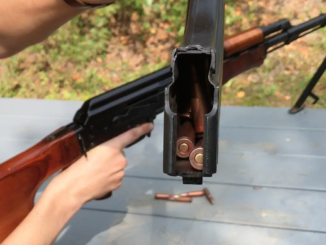When Finland took its independence, the most common type of firearms in the country was the Mosin Nagant – and the second most common was the Arisaka. An assortment of Type 30, Type 35, and Type 38 Arisaka rifles and carbines were left to the Finns by former Russian occupying soldiers. Where did they come from? Well, a few were captured by Russian during the Russo-Japanese War. But most of them were rifles purchased by the British from Japan early in World War One to free up scarce SMLE rifles for front line infantry. Once British production caught up with demand, the now-unnecessary Arisakas were sent to Russia as war aid.
The Russians tended to give Arisakas to second-line troops like the British had, using standard Mosin Nagants for the fighting infantry wherever possible. One of the duties that required armed troops but didn’t involve much actual shooting was maintaining the Russian military presence in Finland to guard against possible German attack (Finland being a Russian province at that time). When the newly independent Finland disarmed Russian garrisons, many of the rifles they got were Arisakas.
The Finnish military standardized on the Mosin fairly quickly, but the Finnish Civil Guard used Arisakas into the mid 1920s. Not all of the Arisakas originally captured were actually turned over to the Civil Guard; many were kept by individuals. Those that did enter Civil Guard inventory will typically have Civil Guard district numbers (with “S” prefixes) on the stock or barrel. The Guard did perforce regular maintenance of Arisakas, and a batch of 500 new barrels was purchased from SIG in the 1920s to replace worn-out barrels – these are marked with SIG’s name on the side of the chamber, and are very scarce to find today.
The only typical mechanical modification found on Finnish Arisakas are Russian in origin – changes to prevent the magazine release form being accidentally pushed by a heavy glove. Some examples have the magazine release button ground down, and some have a small sheet metal clamp fitted to prevent accidental pressing of the release. These rifles will also have a Tokyo Arsenal insignia overstepped on the chrysanthemum, done when the rifles were originally sold to the British.




A decade or so ago I read a long account of the various travels of the Arisaka — some of the British-purchased rifles went to Lawrence of Arabia! At the time of writing the only western manufacturer of 6 x 50 ammunition was Norma of Sweden — for the Finnish hunting market, to feed these ex-Russian Arisakas. At that time a shooting-condition Arisaka could be had in the US for $99, many of them manufactured in the Manchuria factory during or right after World War II, either by the Japanese occupiers or by Mao’s government. What a fascinating story…
I read about Finnish soldiers who served in the Russian Army, when Finland was part of Russia, bringing home captured Arisaka rifles as spoils of war. There also seems to be a fair number of those, though I only have one written account, based on the authors personal knowledge from hunting in Finland. He encountered them as hunting rifles during the 1950ies and was told that they were brought to Finland by their respective owners and kept for hunting. Once I get the opportunity, I will update my comment with the source.
I think the British also dumped a large amount of 6.5mm Arisaka ammunition in Russia during the civil war. As I’ve been told,this is in part how the Automat ended but being chambered in 6.5 Arisaka: available, lower powered than 7.62x54r, and not rimmed.
http://smallarms.ru/carticle?ammo=ar65
Russian Empire do ordered following amounts of 6,5 mm Arisaka cartridge.
660000000 using British credit
124000000 using Japanese credit
In year 1915…1916 this cartridge was produced in Petersburg (up to 200000 per month)
I remember hearing about a sporterized arisaka in 6.5 swede that somebody’d seen in Minnesota or maybe upper michigan and wondering why anybody would bother, but Finland makes a lot of sense for an origin now that I think about it.
More than likely, not. Not a lot of old surplus sporting arms like that get exported from Finland to the US. More likely, it was someone who wanted to shoot their Arisaka, couldn’t find the ammo, and glommed onto 6.5 Swedish as a solution. Since the 6.5 Arisaka is smaller than the Swedish round, all you’d need would be a chamber reamer, and there you go.
I vaguely remember reading about someone advising this conversion, back in the dark ages of the 1970s, when you couldn’t find 6.5 Arisaka anywhere. The idea was that the 6.5 Swedish was more available, and you didn’t have to swap the barrel out when you did it, or redo the bore. Just a quick chamber ream, and away you went…
I have absolutely no idea how prevalent it might have been, and I only barely remember it as a “thing” from reading old gun magazines and such from the 1950s-1960s, which a family friend had in abundance. No idea when the article might have been published, either… He had stuff from all three decades laying around his basement. I might not even be remembering it correctly, at this point…
https://en.wikipedia.org/wiki/.257_Roberts#Conversion_of_war-souvenir_Japanese_Arisaka_rifles claims that Japanese Type 38 Arisaka rifles brought to the United States as wartime souvenirs were sometimes converted by rechambering to utilize more readily available .257 Roberts cartridge cases because commercially produced 6.5×50mm Arisaka cartridges were scarce prior to distribution by Norma Projektilfabrik A/S. The neck of the Roberts case would be slightly enlarged to accept handloaded 6.5 mm bullets. The modified Roberts cases are sometimes known as 6.5×.257 Roberts…
The British Arisakas were originally purchased by the Royal Navy prior to WWI, as there was a shortage of Long Lee-Enfields during the Anglo-Boer War and the Navy purchased their own rifles. When the SMLE was being designed, it was realised that the Long Lee bayonet would not fit, so they copied the Arisaka bayonet, including the hook quillion on the early bayonets. When the Navy finally adopted the SMLE, the Arisakas were sold off.
Why would Britain capture rifles from Japan in WW!? The Japanese were on the side of the Allies in the First World War.
They didn’t. It tells you in the article: The British PURCHASED large numbers of Japanese Model 30, 35, and 38 rifles to use as second-line weapons so that scarce (at the time) SMLEs were available for front-line troops. The RUSSIANS captured some of the Model 30, and perhaps some 35s (not likely, as these were naval issue) in the Russo-Japanese War of 1904~1905.
At one time, the Japanese were one of the world’s leading small-arms manufacturers and exporters.
Britis didn’t capture, they bought from Japan since they have rifle shortage in the beginning of the war
Point of Order:
The only true ‘Arisaka’ in this bunch is the Model (not ‘Type’) 30, designed in 1897 by General Arisaka Nariakira (d.1915). The Model 35 (1902) is a modified and improved Model 30, and its improvements are courtesy of General Nambu Kijiro; This model was ordered and used by the IJN exclusively The Model 38 (1905) that followed was actually a Nambu design, with Arisaka merely being the design bureau head and thus getting the credit. All subsequent major Japanese rifle designs were Nambus, not ‘Arisakas.’
Where does that put the 6.5 Arisaka Type I, as manufactured y the Italians for the Japanese?
It puts it squarely in the Italian Carcano family. The Type I, for ‘Italian,’ pronounced ‘Ee’ by the Japanese, is strictly an M1891 Carcano produced for the Japanese Navy with a Carcano action and barrel, coupled with a Model 38-style Mauser staggered-box integral magazine fed with standard M38 stripper clips, and other features and hardware making it look very much like a Model 38, down to the two-piece dovetailed buttstock.
It has NOTHING to do with ‘Arisaka’ or ‘Nambu’ in any way. I have one built by Beretta, of all things.
Many of these rifles were captured after the fall of Kwajalein and Rabaul, having never been issued. Something like 120,000 were produced in total starting in 1938.
The practice of sending other nations lent, sold, captured and/or “fell off the truck weapons is fascinating.
It seems bizarre at times; country “x” doesn’t have enough rifles for themselves, but they send country “Y” weapons they acquired from “Z” after that country’s surrender. Then a few years later”X” is trying to buy guns from “&”.
It reminds me of when I was researching peanut production; United States was exporting peanuts to Brazil and Brazil was exporting peanuts to the United States the same time.WTH?
Russian Empire in 1913 did not excepted long-lasting full-scale war, when war broke out they found loss rate for rifles to average 200000 examples per month, taking that in account what they have at disposition would be enough just for three months.
So they start searching for rifles among allies and they get
http://militera.lib.ru/memo/russian/fedorov_vg/06.html
450000 x Gras 1874 single-shot rifle from France
105000 x Gras-Kropatschek 1874-1885 magazine rifle (capacity 8) from France
400000 x Vetterli 1870-1887 magazine rifle (capacity 4) from Italy
39000 x Lebel 1886-1907 magazine rifle from allies
60000 x Arisaka 1905 magazine rifle from allies, ex-Royal Navy
This was added to then in service (default) 3-line rifles [Mosin], (older default) Berdan rifles, captured Austrian rifles [Mannlicher]. This rendered Russian Empire use uncommonly big number of rifle systems during Great War.